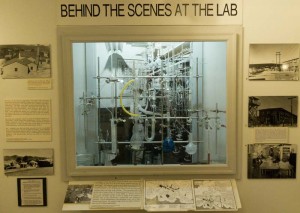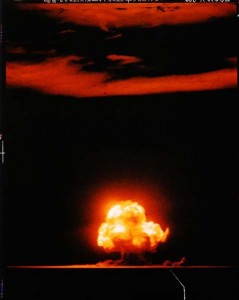It was a day in both the past and the present. We rode the free bus in to Los Alamos this morning, arriving before any of the museums opened, so we just walked a bit and then stopped at Ashley Pond (which should really be “Ashley Pond Pond” as it is a pond named after Ashley Pond) in the historical part of the city.
When the museum opened at 10 am we toured the historical museum, which is small, but crammed with exhibits and a lot of text to read about the Los Alamos area, both before the war, but especially of the reflections of people who lived here during the Manhattan Project. There was an exhibit of the work of by Jack Abey called “Jack Aeby: His Life and Work Beyond the Blast” and coincidentally there was an individual filmmaker there shooting a documentary about him. He was one of the photographers that worked filming the Manhattan project, and took the only color photos of the Trinity test explosion.
He is now 89 years old, but it was interesting to hear him speaking to his daughter about his thoughts about the past. His biggest complaint was that many copies of his famous picture of the explosion are printed backwards (including this one which is from the Time-Life collection).
Perhaps my most disturbing thought about the museum has to do with the process of aging. The equipment they were displaying that came from the project chemistry labs was far too familiar, consisting of things that I used over forty years ago. This equipment was closer in age to the equipment I used to complete my Ph. D. than todays equipment is!
After lunch we walked to the Bradbury Science Museum, which is funded by Los Alamos National Laboratory. Some of the history section was a duplicate of what we saw this morning, but the displays about their modern research were very interesting and well done. On the way back on the bus we coincidentally met our campground neighbours, who are from BC. They too had spent the day in Los Alamos. Both they and we had the impression that Los Alamos is not a town that is short of money!


